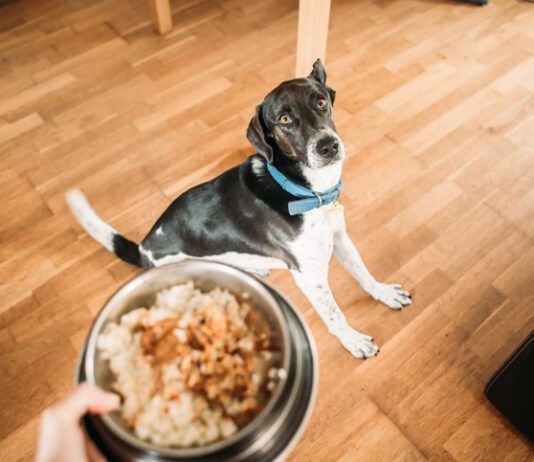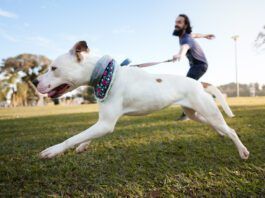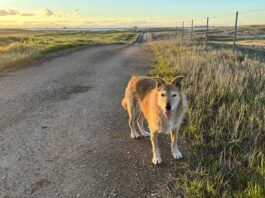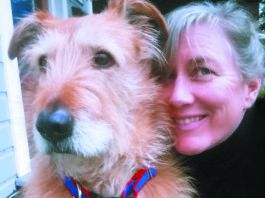Quiet Time
We have been living in the historic downtown of this Gold Rush-era town for the past 11 years. There have been some wonderful benefits of living in an old neighborhood in a cute, old small town. I could go out my front gate with my dogs and walk four blocks to a paved trail alongside the Feather River, which flows right through town. The historic center of Oroville is a bit like a ghost town at night; there are no businesses, not even bars, that stay open past 10 p.m., so on hot summer nights, the dogs could safely walk with me off-leash downtown. When I'm on deadline and don't have time to take Woody out for a miles-long hike to wear him down, I often walk him at night to a grassy area that surrounds some government buildings downtown (two blocks from my house!), to play fetch with a glow-in-the-dark ball.
Train Without Pain
The problem is, many dog owners have little understanding of animal behavior or training, poor animal behavior-observation skills, and bad timing. When you put a tool that works by causing pain in their hands, the result is often poor. Those who consistently hurt sensitive dogs or inadvertently punish dogs when they are doing the right thing are likely to produce dogs who resent and/or fear their handlers and/or walking on leash. Handlers who are uncomfortable with or not strong enough to hurt their dogs with these tools almost always end up with dogs who continue to display deplorable behavior on leash those dogs who just pull right through the discomfort of a tight, choking or pinching collar but who are also now stressed and anxious about this continual discomfort.
Switch Your Dog’s Food Up
I almost never feed my dogs the same food from bag to bag or can to can. I switch foods constantly, rotating among brands, varieties within brands, and forms of food (wet, dry, frozen, dehydrated, home-prepared). All the foods I feed are good ones, I tell my friends and acquaintances; I would never feed just one!
Panacea or Poison?
Many people use the phrase holistic healthcare" when they
Sure to Help
I had an epiphany when my adolescent Lab/pit-mix, Woody, swallowed a small tennis ball (after 6 on a Friday night, no less): Such an exuberant, athletic, and spontaneous dog needs insurance. And Otto, my scruffy heart-dog does, too. He's a big dog and closing in on 10 years old, an age that prompts concerns about things like cancer.
Support Group
Thanks very much for the many compassionate messages of support and sympathy for the tragic loss of Tito and my former foster dog, Ruby. Many readers commented on the post I wrote on the Whole Dog Journal blog page about the incidents that led to the dogs' deaths (one as a result of injuries, and one by euthanasia) and many readers told their own heartbreaking stories dog-aggressive dogs that they loved and tried to rehabilitate.
A Cautionary Tale
Last month, I told you that WDJ's Training Editor Pat Miller and I had been discussing the possibility of writing an article about dogs who kill other dogs; over the span of a few months, Pat had received calls from three different people who had a dog killed by one of their other dogs. After much thought and discussion, Pat wrote a terrific article on how to manage a beloved family dog who, incongruously, appears to have the potential for this horrible deed.
Reduce Reactivity
I don't claim to have all the answers, but, in my opinion, becoming aware that we have a problem is how we start fixing it. Much of our society is anxious and mad right now and so are our dogs. For their sake, and ours, and that of our country, I think we all need to take a breath and practice calming ourselves and each other. We can use the techniques trainer Stephanie Colman describes in her article in this issue! Changing our own emotional responses to things that reflexively make us angry and anxious can't help but improve our moods and just may improve our dogs' moods, too.
While My Dogs Were Away
Recently, I went on a vacation a dog-free vacation. It was strange to not pet dogs for a week and I kept having that startling sensation that I had forgotten to feed them but it was interesting to receive reports from the people who were taking care of mine. Nine-year-old Otto stayed at my sister's house. Otto is tired of other dogs, having been present for the comings and goings of countless foster dogs and puppies over the past few years, and even though my sister has four small dogs, I thought her house would be the best spot for him.
A Good Time
It's amazing to me how many times I've assigned an article to one of WDJ's regular contributors, or one of them has approached me about writing an article, and within days of receiving that article, I'm suddenly faced with the subject of the article in person so to speak.
Whole Dog Journal’s New Look
I couldn't be more excited about the changes you will see in this month's issue of WDJ, not least of which is the new illustration of a dog on the cover, which was based on a photograph of my nine-year-old mixed-breed dog, Otto! Nepotism may have gotten Otto the spot, but I honestly think he serves as a perfect representative of what WDJ is about: a vibrantly fit, happy, intelligent, confident everydog.""
For New Whole Dog Journal Readers: What to Expect
In any given month, we have a number of new subscribers people who are opening the pages of Whole Dog Journal for the first time. They may have heard about us from a friend, trainer, or breeder. They may have been told that we review commercial foods and discuss home-prepared diets. Or they may have heard that we're a great source of information about dog-friendly training, and offer honest product reviews. They may have learned about Whole Dog Journal when doing a web search for holistic treatments for a vexing health problem afflicting their dog. Within an issue or two or three, they should see that, indeed, we offer all that. But new readers may not realize right away what they won't find in WDJ.



















